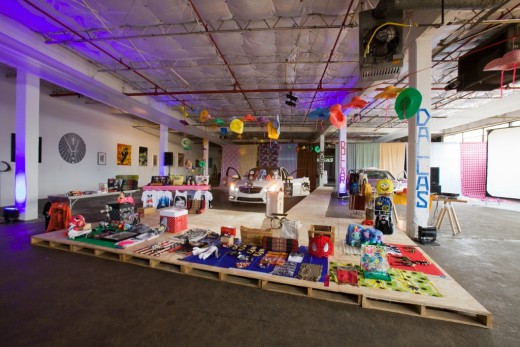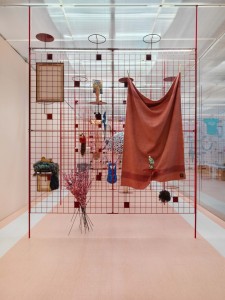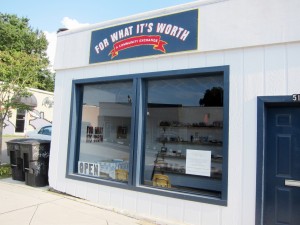NEW BUSINESS: Art in Search of Alternative Economic Systems
Justine Ludwig

A slew of recent articles claim the art market bubble is on the verge of bursting.1. Other recent texts warn of the impending failure of capitalism.2 and point to plummeting oil prices as well as a lack of stability in the Chinese stock market.3 as major causes for concern. In light of this, now is the time to address the relationship between art and finance and seek out the potential for art to inspire an alternative to existing financial systems.
Art, with its readiness to break rules, can function as an experimental, discursive space where alternative economic structures can be addressed. Recent art exhibitions have brought attention to the potential of trade-based barter economies and have sought to revive past alternative economies. These projects, each infused with an activist mentality, expand the definition of artistic practice.
In January, Mexico City–based artist Pia Camil opened A Pot for a Latch at the New Museum in New York. The installation, constructed of modular displays, borrows the aesthetic of commercial space. Upon this structure hangs an assortment of objects, ranging from paintings to hats, records, sports equipment, and other objects more difficult to discern. On designated days throughout the run of the exhibition, viewers are invited to exchange the objects that are hung up with those they bring in. In her invitation to the public, the artist says, “Bring objects of power, of aesthetic interest, and of poignancy. The monetary value of these items is insignificant; their value lies instead in their richness of meaning and in the new life that they acquire on the grid within the Lobby Gallery.”.4
In Camil’s project, it is not the artist who defines what is of aesthetic value, but rather the viewers/consumers. They are invited to acquire either objects that are of use to them or things they simply find visually compelling through acts of exchange. The exhibition title draws from the potlatch ceremony of American Indians from the Northwest Pacific Coast. During these ceremonies, property and wealth were distributed according to social status through the discretion of the host. In preparing for the piece, Camil was inspired by the idea of gift economies, where goods are given without the expectation of equal exchange.

Pia Camil: A Pot for a Latch, 2016. Exhibition view: New Museum. Photo: Maris Hutchinson / EPW Studio
A similar, yet more direct proposal for a trade-based financial model is established in Michael Austin Diaz’s For What It’s Worth, which functioned in Tallahassee for six months in 2014. This neighborhood market ran on communal exchanges where people were invited to trade stories, interviews, and conversation for clothing, food, haircuts, and so on. The intention of the project was to service the homeless community by treating life experience—and a willingness to share it—as currency. There was little to establish this project as a work of art aside from the instigator’s position as an artist.

Michaael Austin Diaz, For What It’s Worth, 2014. Courtesy the artist
Thai artist Surasi Kusolwong makes installations and performances that draw inspiration from consumer society and the economy, encouraging social interaction over economic exchange. In his 2011 project at Dallas Contemporary, Kusolwong took up residence in the gallery space, culminating in a one-night performance in an informal interactive space. During this event, everyday objects were sold off—all for the cost of one dollar, regardless of their actual market value—breaking down the hierarchy of value. Goods supplied ranged from laundry hampers to tennis shoes to pieces of rope.
While these projects co-opt the language of commerce without offering a sustainable alternative to the capitalist model, other artists have aimed to create their own economies. This is the case of the project Time/Bank organized by e-flux, which is modeled after the Cincinnati Time Store, an experimental general store created by anarchist and jack-of-all-trades Josiah Warren that operated between 1827 and 1830. Warren created his own type of currency, one directly tied to time itself. Both labor and goods would be recorded as a measurement of time and not be tied to any financial system. The store made no profits, as it was based on a system of exchanging labor for labor. Goods would be purchased with labor notes stating, “Due to Josiah Warren, on demand, thirty minutes in carpenter work—John Smith,” or “Due to Josiah Warren, on demand, ten minutes in needle-work—Mary Brown.”.5
Time/Bank, launched by Julieta Aranda and Anton Vidokle in 2010, follows the format of the Time Store, but recasts its alternative economic system as an art project. As with the Time Store, services are exchanged for “hour notes.” Reinforcing the role of Time/Bank as a social practice work of art, these hour notes are designed by pioneering text artist Lawrence Weiner. Time/Bank, in contrast to focusing on basic goods and services like the Time Store, is geared toward the creative community with a particular focus on those who do not produce commodities. It offers an exchange of skills such as teaching someone how to mold silicone, translating texts between languages, or helping install an exhibition. While the project does continue to function and pop up in various exhibitions, sadly it is now mostly defunct, as its message boards are spammed with exhibition listings rather than offers of labor exchange.
Writer and activist Fran Ilich’s Spacebank (2011) is an investment bank built on capitalist trading structures, but uses an alternative currency, which is backed by Ilich’s own labor. Spacebank is based on the fictional currency digital material sunflower, managed by the Digital Material Central Bank. The goal of the bank is to support socially conscious projects. It runs like other banks, offering the opportunity to open accounts and receive a Spacebank debit card. Another project by Ilich, Diego de la Vega Coffee Co-op (2014), similarly disrupts traditional economic systems. This business produces coffee, which can be traded for alternative currency and time deposits with the goal of connecting anti-capitalist social movements.
These projects open up a space for discussion and experimentation where we can imagine different manners of commodity exchange. They also pose the question, “How are works of art funded if they opt to work against established financial models?” The þit (2014) by Maíra das Neves and Pedro Victor Brandão used three cryptocurrency mines to create a self-funding model to run a communal park and its programming. These mines use algorithms to amass the digital asset, Bitcoin, that can be exchanged for physical currency. The installation was financially self-sustaining and, once dismantled, two of the cryptocurrency mines were given to other cultural initiatives to support their financial wellbeing. The þit addresses how art, which looks to divorce itself from established economic models, must also posit an alternative to art market reliance.
The designation as work of art, which each of these projects has adopted, provides a façade of levity to serious subject matter. Each proposition for alternative financial modes earnestly calls for consideration. Fully taking advantage of artistic production as a space where experimentation is embraced, these artists point to the social responsibility and practical application of creative thought.
Justine Ludwig is director of exhibitions and senior curator at Dallas Contemporary.
1 See several articles written in response to the results of a study conducted by the University of Luxembourg: Roman Kräussi, “Is there a Bubble in the Art Market?” Journal of Empirical Finance 35 (January 2016): 99–109; Henri Neuendorf, “Academics Say the Art Market Bubble is about to Burst—Are They Right?” Artnet, January 19, 2016, https://news.artnet.com/market/art-market-bubble-report-409136; Edward Helmore, “Art Market in ‘Mania Phase’ and Risks Bursting of the Bubble, Report Says,” Guardian, January 17, 2016, http://www.theguardian.com/artanddesign/2016/jan/17/art-market-mania-phase-bubble-report.
2 Drew Hansen, “Unless it Changes, Capitalism will Starve Humanity by 2050,” Forbes, February 9, 2016, http://www.forbes.com/sites/drewhansen/2016/02/09/unless-it-changes-capitalism-will-starve-humanity-by-2050/#129ed2014a36.
3 Kelly Crow, “A Widespread Chill in Art Sales,” Wall Street Journal, January 28, 2016, http://www.wsj.com/articles/a-widespread-chill-in-art-sales-1454012388.
4 Artist’s invitation: “A Pot for a Latch,” http://www.newmuseum.org/exhibitions/view/pia-camil.
5 William Bailie, Josiah Warren, the First American Anarchist: A
Sociological Study (Boston: Small, Maynard, 1906), 10.









